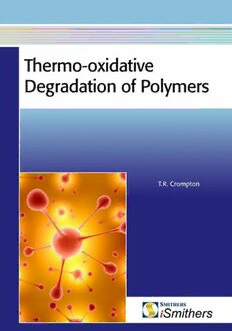
Thermo-oxidative Degradation of Polymers PDF
146 Pages·1.447 MB·English
Most books are stored in the elastic cloud where traffic is expensive. For this reason, we have a limit on daily download.
Preview Thermo-oxidative Degradation of Polymers
Description:
The oxidative and thermal degradation of polymers has very important implications on their suitability for particular end-user applications. Particularly in relation to their physical properties and the lifetime over which the manufactured article retains these properties, after which they become unsuitable for purpose. Correct selection of polymer type, the method of manufacture and the addition of chemicals that slow down the polymer degradation means that manufactured articles can be produced which have suitable processing and end-user physical properties such as tensile strength and avoidance of embrittlement. Particular applications which come to mind are critical applications of polymers to the manufacture of electronic components and the design of polymeric alloys for aircraft fuselage assembly which retain their properties for many years over which the alloy must retain the physical properties at high or low operating temperatures. A particular area of growing importance is the recycling of manufactured components for re-use. Here, the polymer must retain its thermo oxidative resistance properties over a number of remouldings A wide and increasing range of types of polymers are being used in these critical applications and an understanding of thermo oxidative processes will be very important in developing new applications in the future. This book brings together information on the thermooxidative resistance of polymers to change during processing and end-use life. Our present understanding of the chemical changes of the polymer that accompany degradation are also reviewed and the analytical methods by which changes can be ascertained are also discussed. The principle techniques used in thermooxidative studies are based on thermal analysis methods such as thermogravimetric analysis and differential scanning calorimetry and on methods based on polymer pyrolysis followed by gas chromatography and mass spectrometry and/or infrared spectroscopy of the volatiles produced. Other techniques which have have been include nuclear magnetic spectroscopy, electron spin resonance spectroscopy and methods based on chemiluminescence and positron annihilation lifetime mass spectrometry. Details of the more important techniques are discussed in Chapter 1. Chapters 2 to 6 are an organised review of recent work. Various classes of polymers, based for convenience on their elemental composition, namely carbon/hydrogen and oxygen or halogen or nitrogen or silicon types of polymers. This book will be of interest to those involved in the investigation of polymer stability and studies of the mechanics of polymer degradation, to polymer manufacturers and those who use polymers to manufacture end-use articles. The book will also be of interest to those involved in the manufacture of stabilisers for oxidation resistance for use in polymer manufacture, mechanical engineers and designers of polymer products. Students engaged in these disciplines will have much to learn about the stability of polymers in critical applications.
See more
The list of books you might like
Most books are stored in the elastic cloud where traffic is expensive. For this reason, we have a limit on daily download.
